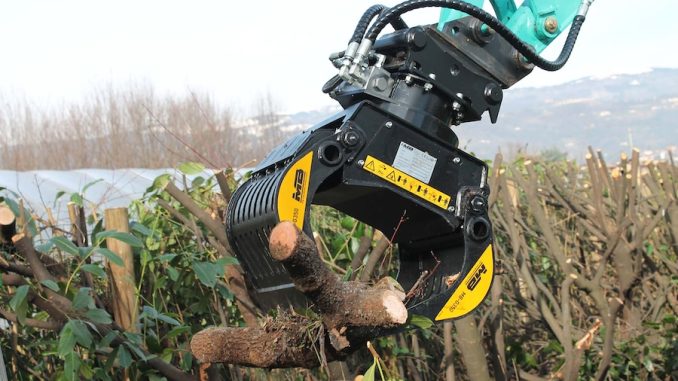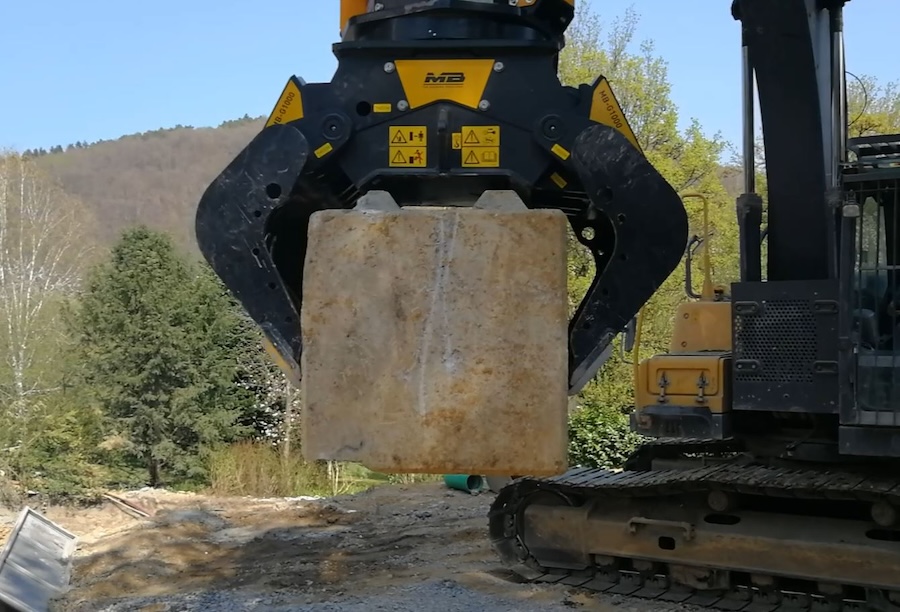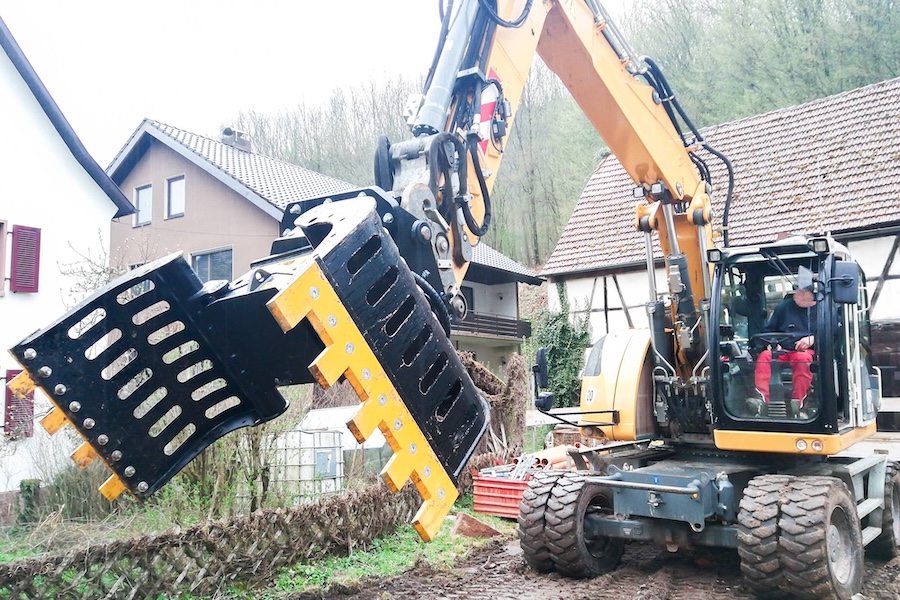
View the complete article here.
When it comes to construction and material handling, grapples play a pivotal role—adapting to various environments from forestry to urban demolition sites. This guide covers the different types of grapples: rotating, demolition, log and lumber, and stone and sorting grapples—each engineered for specific tasks and challenges. We will explore their unique features, ideal applications, essential tips for installation, safe operation, and maintenance—providing you with the knowledge to choose and utilize the right grapple for your needs effectively.
Types of Grapples
From rotating grapples that allow for meticulous placement of materials to rugged demolition grapples built for tough environments, these attachments enhance productivity and safety in operations ranging from forestry to waste management. The most common types of grapples include…
Rotating Grapples
Rotating grapples are versatile attachments designed for precision handling and manipulation of materials. These grapples can rotate 360 degrees, allowing operators to position objects with high accuracy. Advantages of rotating grapples include improved control over material handling, which reduces time and labor costs—and enhances safety by minimizing the need to reposition machinery. However, they have limitations—such as higher maintenance requirements due to their mechanical complexity and higher initial costs compared to standard grapples.
Demolition Grapples
Demolition grapples are robust and are specifically built to handle heavy and irregular materials typically found in demolition sites. These grapples have a strong gripping power and are usually made of high-strength steel to withstand harsh conditions. Best practices for using demolition grapples include regular inspection for wear-and-tear, using them to their full capacity to reduce job time, and ensuring that hydraulic systems are correctly tuned to handle the heavy loads without compromising the equipment’s integrity.
Log and Lumber Grapples
Designed specifically for the forestry industry, log and lumber grapples are tailored to handle round objects such as logs and timber. These grapples often feature curved arms that cradle the logs, preventing damage to the material. Specific design features include high-strength materials to resist abrasion and impacts, and hydraulic dampening systems to handle the dynamic loads of shifting logs. Operators should be trained on the precise handling techniques to maximize the efficiency and safety of their operations.
Stone and Sorting Grapples
Stone and sorting grapples are essential tools in industries involving bulk material handling, such as waste management and recycling. These grapples are designed to pick through debris and sort different materials effectively. Applications include sorting recyclables from other waste, organizing stone at quarries, and loading sorted materials into processing machines. The versatility of these grapples makes them valuable in settings that require high levels of material sorting and organization.

Installation of Grapples
Properly installing grapple attachments is essential to maximize their functionality and ensure safe operation. This section outlines a comprehensive process starting with a pre-installation checklist to prepare your equipment, followed by detailed steps for the mechanical and hydraulic setup, and concluding with post-installation checks to verify the system’s performance.
Pre-Installation Checklist
Before installing a grapple, it’s essential to prepare thoroughly to ensure safety and functionality. The pre-installation checklist should include:
- Tool and equipment verification: Ensure all necessary tools and installation equipment are available and in good condition.
- Equipment inspection: Examine the grapple and the host machine for any signs of damage or wear that could affect operation.
- Safety protocols: Review and implement all relevant safety protocols, including personal protective equipment (PPE) for all installation personnel.
Step-by-Step Installation Guide
Proper installation is crucial for the optimal performance and safety of grapple attachments.
Proper installation begins with ensuring the grapple is compatible with the host machine, such as excavators or backhoes. Align the grapple attachment points with the machine’s arm and secure them using the provided pins and locks, ensuring a stable and safe connection.
Next, connect the hydraulic hoses from the grapple to the machine. It is crucial that these connections are tight and secure to prevent any leaks. After the hoses are connected, check the hydraulic system pressure and adjust it according to the grapple manufacturer’s specifications to ensure smooth and efficient operation.
Post-Installation Checks
After installation, conducting thorough checks can prevent operational issues and enhance safety.
- Operational testing: Operate the grapple in all intended modes to verify functionality.
- Inspection for leaks and loose connections: Check all hydraulic lines and connections for leaks or looseness.
- Performance evaluation: Test the grapple with various loads to ensure it operates efficiently and safely under typical working conditions.
How to Use Grapples Safely and Efficiently
Proper usage of grapple attachments not only maximizes their performance but also ensures operator safety and extends the equipment’s lifespan.
Operational Best Practices
To maximize the efficiency and longevity of grapples, it’s crucial to adopt certain best practices. Operators should ensure that the grapple is used within its operational capacity to prevent overstressing the equipment. Techniques such as smooth operational controls and avoiding abrupt movements can significantly reduce wear-and-tear. In addition, regular checks to ensure that hydraulic pressures are optimized for the specific task can enhance performance and efficiency.
Safety Protocols
Safety is paramount when operating grapples. Operators should always wear the appropriate personal protective equipment (PPE)—including gloves, goggles, and helmets. It is essential to ensure that all bystanders are at a safe distance when a grapple is in operation. Furthermore, before beginning work, operators should perform a routine check to ensure that all parts of the grapple are securely attached and that the equipment is functioning correctly—to prevent any accidents due to equipment failure.
Maintenance Tips
Regular and preventive maintenance is key to extending the lifespan of grapple attachments. This includes routine inspections for hydraulic leaks, checking for any loose bolts or wear in the pins, and ensuring that all moving parts are well-lubricated. Operators should also follow the manufacturer’s guidelines for service intervals and replace any worn-out parts promptly. Proper storage of the grapple when not in use can also prevent undue wear and corrosion.

Buying Tips for Grapples
Selecting the ideal grapple requires understanding its specifications, assessing new versus used options, evaluating potential vendors, and considering the overall cost implications.
Understanding Specifications
When purchasing a grapple, it’s important to consider various specifications to ensure it meets your needs. Key features include the size of the grapple, which should be compatible with the host machine—weight capacity, which determines the load the grapple can handle—and rotation ability, which affects maneuverability and precision. Ensuring these specifications align with your project requirements will enhance efficiency and productivity.
New vs. Used
Deciding between a new or used grapple involves weighing several factors. New grapples come with the latest technology and minimal wear, typically accompanied by a manufacturer’s warranty—but at a higher cost. Used grapples can offer significant savings—but it’s essential to inspect them thoroughly for signs of wear, hydraulic integrity, and overall functionality to avoid future maintenance costs.
Vendor Evaluation
Choosing the right supplier is crucial for acquiring a quality grapple. Look for vendors with positive reputations, verified customer feedback, and robust after-sales support. Consider the warranty options they offer, which can provide additional security and indicate the reliability of their products.
Cost Considerations
Understanding the full cost involved in owning a grapple goes beyond the initial purchase price. Evaluate the lifetime cost analysis—which includes maintenance expenses, potential downtime, and resale value. A cheaper initial option might end up being more costly in the long run if it requires frequent repairs or replacement parts.
View the complete article here.
What types of grapples are available for different applications?
Grapples available include rotating grapples, demolition grapples, log and lumber grapples, and stone and sorting grapples.
How do you ensure the safe installation of a grapple?
Ensure compatibility with the host machine, secure all connections, check hydraulic pressures, and conduct thorough post-installation checks for leaks and functionality.













































